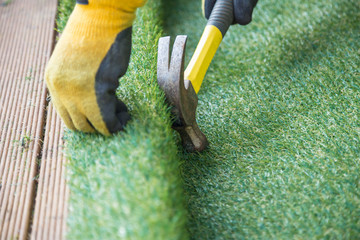Artificial grass is a popular surface of synthetic materials designed to resemble the texture and look of real natural grass. It’s most frequently used in athletic arenas for outdoor sports or is commonly played on natural grass in residential areas. But, over time, it has become increasingly used for both commercial and residential applications as well. There are many benefits to using this type of surface. These include:
The first benefit of installing artificial grass is that it requires minimal maintenance. Even when it is not in use, it’s simple enough to remove dirt or debris and replace it with new dirt. Usually, this is due to the material’s ability to expand or contract based on the temperature and other outside conditions. That means that there is no need to apply chemicals or fertilizer to maintain the appearance of your artificial turf lawn. It can also save you money with its energy-saving capabilities.
Another benefit of artificial turf is that it provides an attractive, pristine appearance for any outdoor space. Unlike natural grass, artificial grass doesn’t require that you mow, weed, or fertilize it. It also won’t break down over time. And, unlike natural grass, which can fade and develop patches, synthetic grass requires very little maintenance. For example, water or liquid spills on the surface won’t cause it to turn brown or splinter. Even when it is in use, it doesn’t appear as if you’re sporting green grass!
Synthetic grass has many benefits but there are also some disadvantages that you need to consider. One of the primary disadvantages is its durability and reliability. Since artificial grass is comprised of multiple layers of materials (gravel, plastic, rubber, or thermoplastic fibers), it’s durable enough to withstand normal and large amounts of rain or moisture. However, this doesn’t mean that you can leave it in your backyard all year long-it will eventually deteriorate due to constant exposure to the elements.
To maintain its integrity and durability, infill material (a type of topsoil) is often needed. Typically, artificial grass blades require approximately two inches of infill every two weeks. This infill is typically made from high-quality materials such as rubber, rocks, or stones. Over time, it becomes saturated with moisture, which weakens its structure and can cause cracks.
If you’re looking for a low-maintenance alternative to natural grass, artificial grass synthetic is an ideal choice. However, there are several drawbacks to using artificial grass synthetic. First, the blade system used to install it can cause damage to the surrounding areas of the lawn. If not installed correctly, the blade can also damage the surrounding soil. Furthermore, infill material can deteriorate quickly, making it necessary to replace it frequently.
When installing artificial grass, whether in a sports field, golf course, or another area, it’s important to follow the manufacturers’ directions. Different products offer different installation procedures and specific recommendations for any given situation. Some of the general recommendations include putting greens that are laid directly on top of the soil, as opposed to installing in a raised bed or other types of base, and installing them in the United States.
Overall, artificial grass installers should make sure they are using the proper materials and techniques to avoid damage to the turf and surrounding soil. The most important factor to remember is that artificial grass does not have the same durability and strength as natural grass; therefore it’s important to choose high-quality weed killers and fertilizers. Additionally, some homeowners prefer to have their artificial grass professionally installed to ensure that it matches the exterior and appearance of their home. By using high-quality weed killers and grub hoes, residential, artificial grass installers can prevent the growth of harmful weeds. For professionals to help you, you must get in touch with them and let them know what you need by visiting their website.
